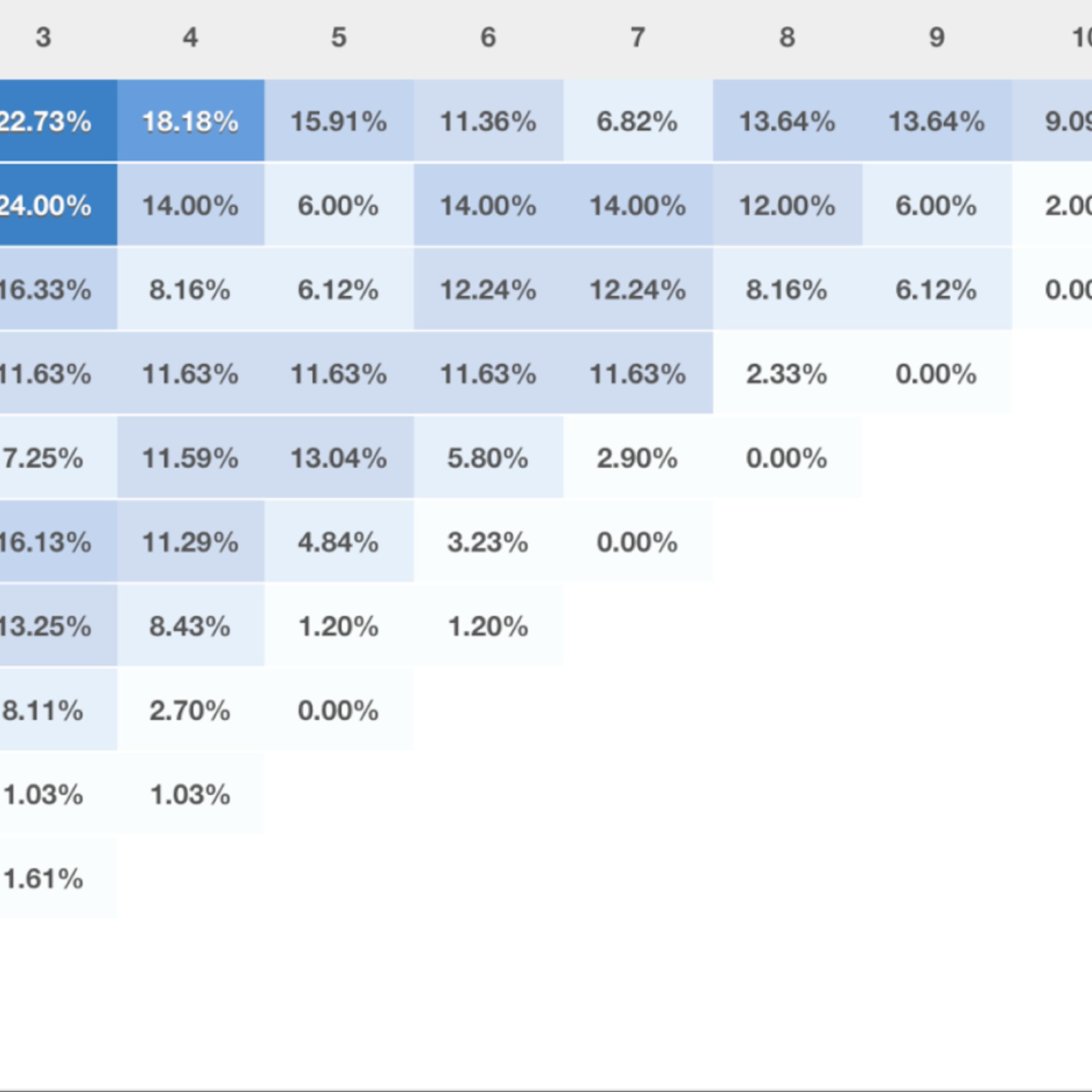Podcast Summary
Understanding user engagement and retention: Analyzing user engagement through cohort analyses helps companies retain and re-engage users, adjusting strategies based on changes in user base and marketplaces.
As marketplaces and platforms evolve, understanding user engagement and retention is crucial for long-term success. After acquiring users, companies need to keep them engaged to retain and even re-engage them. The user base changes over time, and these changes impact engagement and user lifetime value (LTV). For instance, rideshare platforms have seen a shift from urban to suburban and rural users, leading to different engagement levels and LTVs. Engagement is important because it shows user stickiness and is harder to hack than acquiring new users. Companies can analyze user engagement by looking at cohort analyses, which compare the activity of users who join during specific time frames. This analysis helps companies understand the effectiveness of their engagement strategies and adjust accordingly. Successful companies progress from a focus on user acquisition to engagement and retention. For instance, Pinterest, which has a large user base, now prioritizes engagement to re-engage existing users and scale its user base further.
Analyzing user behavior through cohorts is vital for growing businesses: Cohort analysis helps identify trends, assess impact of new features, and maintain growth by addressing churn and re-engaging lapsed users. Network effect insights reveal improved engagement for new cohorts.
Understanding user behavior over time through the analysis of cohorts is crucial for growing and optimizing a business, particularly those with network effects. Cohort analysis allows companies to identify trends in usage patterns, spot potential increases or decreases in engagement, and assess the impact of new features or offerings. The shapes of these cohort curves often follow a similar pattern, with activity levels tapering off before potentially rebounding for the most engaged users. It's essential to compare different cohorts against each other to determine if the business is improving or declining. For new startups, the primary focus is on acquiring new users due to the limited user base. However, as a company grows, the emphasis shifts towards addressing churn and re-engaging lapsed users. This evolution is necessary to maintain growth rates and keep the user base engaged. Moreover, in marketplace businesses, cohort analysis can provide valuable insights into network effects. As a service becomes more valuable with more users, new cohorts should exhibit better engagement than earlier ones. If a business can reverse the trend of declining engagement and instead see growth, it's a strong indication that the service has become more valuable, making it a valuable tool for both the business and potential investors.
Analyzing user behavior through cohort curves: Cohort analysis helps businesses optimize engagement and growth by revealing trends and comparing markets or teams, ensuring new users become engaged through effective onboarding, and creating a valuable user experience to foster a network effect
Understanding user behavior through cohort analysis is crucial for businesses to optimize engagement and growth, especially for those with hyperlocal or B2B offerings. Cohort curves reveal valuable insights, allowing comparisons between markets or teams and identifying trends. Post-acquisition, focus on ensuring new users become engaged users through effective onboarding and creating a valuable user experience. The "magic moment" of user realization may not always be a singular event, but rather an accumulation of positive experiences and interactions. Ultimately, a successful product strategy involves careful planning, intentional design, and continuous improvement to create a network effect that keeps users engaged over time.
Identifying the magic moment for user acquisition and engagement: Successfully acquiring and retaining users requires a strategic approach, including identifying the magic moment for user awareness, keeping users engaged, analyzing behavior for long-term users, and leveraging existing user base for upselling opportunities.
Building a successful user base for a business involves a strategic approach to acquisition, activation, retention, and engagement. Entrepreneurs must identify their "magic moment" that creates user awareness of the value proposition, such as Pinterest's need for local content for international markets. Once users are acquired, the focus shifts to keeping them engaged and analyzing their behavior to identify long-term, sticky users. Companies can leverage their existing user base for upselling opportunities instead of constantly acquiring new customers, which is more expensive in the SaaS context. The priorities and leverage in user acquisition change over time based on the company's situation. For instance, Facebook no longer needs to focus on US user acquisition due to its large existing user base. Ultimately, a portfolio approach to thinking about users is essential, as analyzing successful user behaviors and profiles can lead to valuable insights for the business.
Moving Users Up the Ladder of Engagement: To increase user value and engagement, segment users, provide content and education, use incentives, refine the product, and understand user behavior through engagement metrics.
To maximize user engagement and value in a product, it's essential to move users up a "ladder of engagement" from infrequent to daily use. This can be achieved by segmenting users, providing content and education, using incentives, refining the product for specific use cases, and understanding user behavior through engagement metrics like frequency. For instance, Dropbox increases user value by encouraging users to share folders at work, while OpenTable and Airbnb focus on episodic use. Companies like eBay and Dropbox, which offer deep content, can foster high engagement, while others, like OpenTable and Airbnb, may rely on incentives or refining the product for specific use cases. Ultimately, understanding user behavior and tailoring strategies accordingly is crucial for effective engagement and retention.
Understanding User Engagement Metrics: DAU-MAU ratio and L28 are valuable metrics for user engagement, but it's crucial to consider the context of your product and user behavior before interpreting them.
The DAU-MAU (Daily Active Users to Monthly Active Users) ratio is a popular metric for understanding user engagement, particularly in advertising businesses like Facebook. However, it's important to remember that this metric may not be suitable for all types of products. For instance, some products may naturally have lower daily active users due to their infrequent use, such as travel products. Therefore, it's crucial to ensure that the metric aligns with your product's strategy. Another metric to consider is L28 (Last 28 Days) or L7 (Last 7 Days), which provides a frequency diagram of user activity. This diagram can help identify a hardcore segment of users who consistently use the product, which is essential for many products as they rely on a core group to drive the rest of the network. It's also important to note that there are nuances to when to apply these metrics, and it's essential to understand the context of your product and user behavior. For instance, a product with a low DAU-MAU ratio may still be successful if it monetizes through long-term engagement and a small but consistent user base. In summary, while metrics like DAU-MAU and L28 can provide valuable insights into user engagement, it's essential to consider the specific context of your product and user behavior when interpreting these metrics.
Engagement is crucial for long-term success of a venture business: Engagement is hard to manipulate, leads to valuable user acquisition, drives network effects, and creates a loyal user base for long-term success
Engagement is a crucial factor for the success of a venture business beyond just growth. While growth is necessary, investors are particularly interested in a large, engaged audience because it leads to valuable user acquisition. Engagement is hard to game and is the driving force behind various acquisition loops. Unlike growth, which can be easily manipulated through email notifications or paid marketing, engagement requires people to genuinely connect with a product. Network effects, which make a platform more valuable as more users join, also apply to engagement. Cohort curves and user retention rates can indicate the presence of genuine engagement and network effects. Engagement is essential for creating a loyal user base that drives long-term success.
Network effects and engagement impact business success: Understanding engagement and network effects can help businesses make informed decisions about where to invest and how to optimize their products for maximum growth and success.
Engagement and network effects are interconnected and crucial elements for the success and growth of various businesses, especially those with significant network effects. The data from OpenTable's experience in San Francisco illustrates this, as sales rep productivity, restaurant churn, and the number of diners per restaurant all improved over time due to increased engagement. However, it's important to note that network effects are not binary or equal in all cases. Instead, they follow a curve, with more significant improvements seen in areas with larger user bases or market shares. For instance, cities with more restaurants typically have higher conversion rates. Engagement and retention are related but distinct concepts. Low-frequency, high-retention products, like weather apps, are essential because users need them consistently but may not engage frequently. In contrast, high-engagement products, like games or ebooks, offer immediate gratification but may have lower retention rates once the user has finished using them. Understanding these nuances can help businesses make informed decisions about where to invest and how to optimize their products for maximum engagement and network effects.
Measuring Consumer Product Success with Engagement and Retention: Companies measure consumer product success through engagement (frequency and duration of use) and retention (repeat usage). Engagement is influenced by product format and competition, while retention depends on user experience and value proposition.
Engagement and retention are two distinct metrics for measuring the success of consumer products. Engagement refers to how frequently and how long users interact with a product, while retention measures if and how often they return after an initial use. Companies have different cadences for these metrics depending on the product type. For instance, Netflix's binge-watching format significantly impacted engagement numbers by taking users' minutes away from other apps. Additionally, content and attention competition comes from various sources, including social media, videos, and even dating apps. Google is an excellent example of a company that excels in micro-interactions, utilizing small time blocks for user engagement. Ultimately, to build successful consumer products, companies need to focus on at least one of these axes - engagement, retention, or monetization.
Measuring consumer business retention: Google prioritizes frequency and monetization, while other businesses focus on upstream signals. Companies must tailor retention metrics based on business strategy and user behavior, and iterate to improve through data analysis.
Assessing the retention of a consumer business can be challenging due to the varying definitions and frequencies of user engagement. Google, for instance, prioritizes frequency and monetization over engagement, while other businesses may focus on upstream signals like website visits or app checks to gauge user interest. The concept of churn is also tricky, especially for episodic or infrequent use products. Companies must tailor their retention metrics based on their business strategy and user behavior. To navigate the dance between architecting and discovering, it's essential to iterate, develop hypotheses, and test them through data analysis. Ultimately, the better consumer internet companies focus on understanding their metrics and improving their business through data-driven insights.
Understanding customer value through data-driven decision making: Identify valuable metrics, focus on customer engagement, and iterate based on data to provide value and stay competitive.
Data-driven decision making is crucial for businesses to understand their customers, improve engagement, and drive growth. Companies should focus on finding the right metrics that demonstrate value to their customers and build strategies around those metrics. The nature of a product can influence the choice of metrics, as some products may have a low daily active user (DAU) count but high monetization. It's essential to identify the loops and networks within a product that foster engagement and continually iterate based on the data. Ultimately, the goal is to provide value to customers and create a product roadmap that reinforces that value. Growth and engagement are key indicators of a successful business, and understanding the data behind these metrics can help companies stay competitive.





